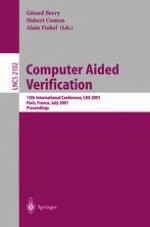2001 | Buch
Computer Aided Verification
13th International Conference, CAV 2001 Paris, France, July 18–22, 2001 Proceedings
herausgegeben von: Gérard Berry, Hubert Comon, Alain Finkel
Verlag: Springer Berlin Heidelberg
Buchreihe : Lecture Notes in Computer Science
Enthalten in: Professional Book Archive
